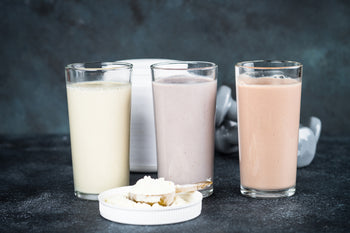 Categories
CategoriesDiet & Exercise
Discover More Articles

It’s no secret that stress can take a toll on our body, mind, and brain. December is not the month to throw your self-care and mental health priorities out the window.

5 Ways to Stay Motivated This Winter
When the seasons change it suddenly becomes harder to get out and exercise. Winter fitness programs aren’t the easiest to stick to, but they’re imperative to your overall health and well-being. So with that in mind, let’s take a look at what you can do to stay motivated and successful with your winter fitness goals.

How to Detox After Holiday Feasts
If you’re having a hard time committing to your diet over the holidays, you’re not alone. And the good news is you don’t have to be perfect to maintain your weight over the holiday season. Try following these simple detox tips after each scrumptious holiday meal and start the new year fresh and ready to finally achieve your health and fitness goals.

High Protein Meal Replacement Shakes
Meal replacement shakes aren’t just low in calories, they’re high in essential nutrients your body needs to keep yourself nourished and your stomach feeling full, while helping also you maintain or lose weight. Protein provides numerous benefits to your body, including fueling the entire body, helping build muscle mass and being a key component to essential substances your body needs, like antibodies and blood.

Skin Cycling: all about the newest trend
The skin cycling hashtag has been viewed over 3 billion times on TikTok—and dermatologists say it's a strategy worth trying.The term "skin cycling" is all about taking a cyclical approach to your facial skincare routine.

Get ready for a plumper, perkier-looking neckline
Meet our new luscious neck cream featuring our proprietary elasticizing bioactive plant blend that targets lines and texture, so your neckline appears smoother, renewed & 10 years younger looking!

TRENDING MAKEUP HACK: BLUSH & BRONZER AS EYESHADOW
By selecting shades that complement each other, you can achieve a harmonious and polished makeup look without the need for multiple products.

5 signs you need more electrolytes
Electrolytes help with hydration by ensuring the body can actually absorb and use the water you drink—preventing dehydration in the presence of sufficient water intake.

Ring In 2025 With ✨ Glowing ✨ Skin…And FREE Boosters!

Better Ingredients, Better You
Your health goals aren’t one-size-fits-all, so your supplements shouldn’t be either. That’s why we designed the Power Line to target different pillars of performance and wellness — from appetite control to anti-aging to athletic power.

The earlier you start teaching your child healthy habits, the more likely they will be to keep them up throughout their lives. The bonus is that you as a parent are forced to develop good health habits, as well. Teaching your children ends up benefiting the entire family!

Tip 1: Eat the Rainbow
Kids love bright colors, so use the bright colors of a wide variety of fruits and vegetables to teach children healthy eating habits. A rainbow of raw and lightly cooked bite-size vegetables and fruits make appetizing and healthful additions to meals or snacks.
The bright pigments found in fruits and vegetables reflect the nutrients they contain within.
Beta-carotene, for instance, is a precursor to vitamin A, which promotes healthy skin and mucous membranes, boosts the immune system, and supports healthy eyes and vision. Beta-carotene shows up as the red-orange pigment you see in carrots, sweet potatoes, cantaloupe, apricots, and sweet red and yellow peppers, although you’ll also find beta-carotene in green vegetables like peas, spinach, and romaine lettuce.
Channel your inner Mary Poppins by turning the challenge of trying out new fruits and vegetables into a game:
- Keep a chart of the colors you eat in a week. Try to beat your record, or list the colors you want to try next week.
- Have children assist you in picking one or two new vegetables at the grocery store or farmers’ market to try.
- Conduct a taste test challenge, where your kids can analyze the color, texture, and taste of each new offering. Create a simple analysis sheet and record their answers (older children can write their own) to give the challenge a sense of importance.
- Teach older children the names of the major nutrients in various fruits and vegetables and how they benefit the body. Playful quizzes during meals will keep the information fresh in their minds and transfer the information to long-term memory, where they can draw on it as they get older and make more of their own food choices.
- Describe the ways nutrients from fruits and vegetables help their bodies grow and be healthy. Use terms appropriate for their ages and that will entice their imaginations, i.e., nutrients dancing with the cells of their bodies; tiny little trains or cars delivering vitamins and minerals to all the parts of their bodies; or nutrients giving their cells big hugs and helping them be healthy.
Tip 2: Exercise Together
Young children are naturally energetic and active, and this tendency needs to be encouraged and supported (except at bedtime, of course).
The danger for many families is that screen time begins to encroach on active time as children get older and decide video games and cartoons are more entertaining than running and dancing.
The average child in America currently watches between 24 and 35 hours of television a week!
While family exercise doesn’t need to be particularly strenuous, it’s the regularity of the activity that cements the habit of exercise.
Families where parents join the children in walks, hikes, bike rides, swimming, team sports, and other activities while encouraging kids to get out and run around on their own and with friends will see greater individual physical activity over a lifetime. Even getting a dog can help you establish regular time for physical activity as you walk and care for your pet.
Tip 3: Emphasize Health, not Body Shape
According to the CDC, one in six children in the U.S. is obese. This crisis may have many aggravating factors, including more sedentary lifestyles, the abundance of cheap junk foods and beverages, increased consumption of prescription medications that cause weight gain, and exposure to environmental pollutants and toxins that disrupt hormone production.
Kids imitate their parents when it comes to eating and activity habits, so if children are obese, chances are the parents are also struggling with their weight.
Focusing on aesthetic appearances frequently backfires, however.
Children whose parents constantly force them onto diets in order to be slim and “look good” are at far greater risk for developing eating and psychological disorders. Instead, the best approach is to emphasize being healthy rather than harping on a particular body shape. Then, get healthy along with your child.
Most kids don’t have a problem staying slim: young metabolisms and high activity levels help them burn excess calories.
However, educating children early on about the benefits of a nutrient-dense diet increases the chances that they will make smarter food choices as they grow, and this will help them maintain a healthy body weight as they get older.
Point out how eating fruits and vegetables makes them feel strong and energetic while eating sugary junk foods will make them feel tired and lethargic after their blood sugar levels crash.
Use age-appropriate ways to help them imagine what is going on inside their bodies when they eat certain types of foods. This kind of knowledge increases a child’s sense of control and choice.
When children know the “why,” they more often voluntarily make better, smarter choices.It’s also important not to complain about your own weight or body shape in front of children. Hearing a parent frequently moan into the mirror about being fat and ugly causes children to look at themselves and wonder if they, too, are ugly and undesirable.
Watching a parent obsess about body shape has led many children, teens, and adults into a spiral of unhealthy fad diets and depression about how they look.
Instead, talk about how great it is to eat foods that will provide the nutrients their bodies need to grow healthy and strong, and then lead by example.
Tip 4: Teach Kids about Portion Sizes and Added Chemicals
As the decades have gone by, portion sizes have grown by leaps and bounds. The CDC reports that portion sizes have quadrupled since the middle of the last century. That means that one of today’s large fast food combo meals would have been enough for four people bellying up to a soda fountain counter in 1950.
While portion sizes have quadrupled since the ‘50s, a horrific array of man-made chemicals have also found their way into what we eat. Unless you’re eating from your own garden or shopping along the edges of the grocery store, you’re consuming a laundry list of preservatives, stabilizers, dyes, colorings, added sugars, and more.
While you don’t want to give your young children nightmares about evil, life-sucking chemicals, there’s nothing wrong with teaching them about proper portion sizes and how to avoid processed foods and their associated chemicals.
Appropriate portion sizes for teens and adults (young children can be given half or less of adult portions depending on appetite and activity level):
One cup of vegetables is about the size of a fist. Strictly speaking, you don’t need to worry about getting too many raw or cooked vegetables unless they are drowning in sauces.
One portion of fruit is one small to medium whole fruit, or pieces of fruit equal to the size of a baseball.
- Dried fruit portions are ¼ cup.
- One portion of meat is about the size and thickness of your palm.
- A portion of whole grain bread is equal to the size of a cassette tape.
- A portion of whole grains such as rice or quinoa is 1/3 cup.
- Pasta portion is also 1/3 cup.
In addition to proper portion sizes, teach your kids to read food labels to see how many serving sizes each package contains. Many packages are consumed as a single serving size when they should actually serve two or more.
Tip 5: Avoid the Factors that Lead to Overeating
Avoid the “clean your plate club” or forcing children to eat everything they take when they are hungry and overestimate how much they can fit into their stomachs. Instead, teach children to eat slowly, chew thoughtfully, taste their food, and stop eating when they no longer feel hungry. As much as possible, serve three regular meals and two healthy snacks throughout the day.
While it’s hard for working parents to do, make it a priority to sit down as a family at dinnertime.Regular meals and snacks and family mealtimes can help to avoid instilling a sense of food anxiety in children, where they get used to stuffing themselves in case they won’t get to eat for long periods of time (this can lead to imbalances in the hormones that regulate a sensation of hunger or satiety, as well as promote fat retention).
Regular meals and snacks also keep blood sugar levels steady throughout the day, which is one of the best ways to maintain healthy weight and avoid becoming hangry, when hunger turns you into a snappish, stressed, and angry person.
Ever had a hangry two-year-old throw a temper tantrum during a shopping trip? We’ve all been there, and sometimes, we wish that we, as adults, could throw ourselves on the floor and kick our heals and scream when we want to be fed, too.




